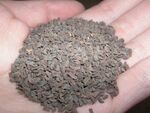Peganum harmala: Difference between revisions
>Jacubensy Nothing that I have found indicates that harmalas are MAOIs. All recent literature says they are infact RIMAs, and the rest of the paragraph would seem to agree with that. Changing this from "MAOI" to "RIMA" makes the whole paragraph sit in agreement, and I believe is more accurate. |
>Jacubensy Nothing that I have found indicates that harmalas are MAOIs. All recent literature says they are infact RIMAs, and the rest of the paragraph would seem to agree with that. Changing this from "MAOI" to "RIMA" makes the whole paragraph sit in agreement, and I believe is more accurate. |
(No difference)
| |
Revision as of 15:15, 4 July 2022
| Peganum harmala | |
|---|---|
 P. harmala in the nature. |
|
| Taxonomical nomenclature | |
| Kingdom | Plantae |
| Unranked | Angiosperms |
| Unranked | Eudicots |
| Unranked | Rosids |
| Order | Sapindales |
| Family | Nitrariaceae |
| Genus | Peganum |
| Species | P. harmala |
| Common nomenclature | |
| Common names | Espand, Esfand, Syrian rue |
| Constituents | |
| Active constituents | Harmala alkaloid |
Peganum harmala, commonly called Syrian rue, harmel, espand, esfand, wild rue, African rue, or aspand, is a plant native to the eastern Iranian region west to India. It has also spread invasively throughout Arizona, California, Montana, Nevada, Oregon, Texas and Washington.[1] The plant itself produces seeds which contain harmala alkaloids and is easily accessible and legal to purchase online.
Chemistry

Powdered syrian rue seeds act as a RIMA at doses of 2-5g. Syrian rue seeds contain several different harmala alkaloids at slightly varying percentages. Only some are monoamine oxidase A inhibitors. In one study, total harmala alkaloids were at least 5.9% of dried weight.[2][3][4] Seed extracts were potent reversible and competitive inhibitors of MAO-A but poor inhibitors of MAO-B.[5]
Total harmala alkaloids were at least 5.9% of dried weight, in one study.[4]
| Beta-carboline[6] | Content |
|---|---|
| 1-hydroxy-7-methoxy-β-carboline | |
| 2-aldehyde-tetrahydroharmine | |
| 3-hydroxylated harmine | |
| 6-methoxytetrahydro-1-norharmanone | |
| 8-hydroxy-harmine | |
| Acetylnorharmine | |
| Desoxypeganine[7] | |
| Dihydroruine | |
| Dipegene | |
| Harmalacidine (HMC) | |
| Harmalacinine | |
| Harmalanine | |
| Harmalicine | |
| Harmalidine | |
| Harmaline (dihydroharmine, DHH, harmidine) | 0.25%[4]–0.79%[8]–5.6%[5] |
| Harmalol | 0.6%[5]–3.90%[4] |
| Harmane (harman) | 0.16%[4] |
| Harmic acid | |
| Harmic acid methyl ester | |
| Harmine (banisterine, telepathinec, yageine) | 0.44%[8]–1.84%[4]–4.3%[5] – The coatings of the seeds are said to contain large amounts of harmine.[9] |
| Harmine N-oxide | |
| Harmol | |
| Isoharmine | |
| Isopeganine | |
| Norharman | |
| Norharmine (tetrahydro-beta-carboline) | |
| Pegaharmine A | |
| Pegaharmine B | |
| Pegaharmine C | |
| Pegaharmine D | |
| Pegaharmine E | |
| Pegaharmine F | |
| Pegaharmine G | |
| Pegaharmine H | |
| Pegaharmine I | |
| Pegaharmine J | |
| Pegaharmine K | |
| Peganine A | |
| Peganine B | |
| Peganumal A | |
| Peganumal B | |
| Peganumine A | |
| Peganumine B | |
| Ruine | |
| Tetrahydroharman | |
| Tetrahydroharmine (THH, leptaflorine) | 0.1%[5] |
| Tetrahydroharmol | |
| Tetrahydronorharman |
Toxicity and harm potential
Dangerous interactions

See the MAOI page for substances that may cause dangerous interaction.
Cholinergics
Cholinergic substances combined with Peganum harmala can cause a cholinergic crisis because the plant contains several acetylcholinesterase inhibitors (AChEIs):
Drug use in pregnancy
Peganum harmala can induce miscarriage. It has traditionally been used as an abortifacient agent in Morocco, North Africa, and the Middle East.[13] It is believed that quinazoline alkaloids such as vasicine and vasicinone are responsible for the abortifacient activity of the plant.[14]
See also
External links
References
- ↑ https://plants.usda.gov/core/profile?symbol=PEHA
- ↑ http://www.phcogrev.com/article.asp?issn=0973-7847;year=2013;volume=7;issue=14;spage=199;epage=212;aulast=Moloudizargari
- ↑ http://www.tandfonline.com/doi/abs/10.1080/15563650701323205
- ↑ 4.0 4.1 4.2 4.3 4.4 4.5 Hemmateenejad B, Abbaspour A, Maghami H, Miri R, Panjehshahin MR (August 2006). "Partial least squares-based multivariate spectral calibration method for simultaneous determination of beta-carboline derivatives in Peganum harmala seed extracts". Anal. Chim. Acta. 575 (2): 290–9. doi:10.1016/j.aca.2006.05.093. PMID 17723604.
- ↑ 5.0 5.1 5.2 5.3 5.4 Herraiz T, González D, Ancín-Azpilicueta C, Arán VJ, Guillén H (March 2010). "beta-Carboline alkaloids in Peganum harmala and inhibition of human monoamine oxidase (MAO)". Food Chem. Toxicol. 48 (3): 839–45. doi:10.1016/j.fct.2009.12.019. PMID 20036304.
- ↑ "Table 4 | Peganum spp.: A Comprehensive Review on Bioactivities and Health-Enhancing Effects and Their Potential for the Formulation of Functional Foods and Pharmaceutical Drugs". www.hindawi.com.
- ↑ Algorta, J; Pena, MA; Maraschiello, C; Alvarez-González, A; Maruhn, D; Windisch, M; Mucke, HA (March 2008). "Phase I clinical trial with desoxypeganine, a new cholinesterase and selective MAO-A inhibitor: tolerance and pharmacokinetics study of escalating single oral doses". Methods and findings in experimental and clinical pharmacology. 30 (2): 141–7. doi:10.1358/mf.2008.30.2.1159649. PMID 18560630.
- ↑ 8.0 8.1 Pulpati H, Biradar YS, Rajani M (2008). "High-performance thin-layer chromatography densitometric method for the quantification of harmine, harmaline, vasicine, and vasicinone in Peganum harmala". J AOAC Int. 91 (5): 1179–85. doi:10.1093/jaoac/91.5.1179
. PMID 18980138.
- ↑ "African rue or Harmel". cdfa.ca.gov. Archived from the original on 22 October 2015. Retrieved 17 February 2021.
- ↑ Studies in Natural Products Chemistry, Volume 43, page 43
- ↑ 11.0 11.1 11.2 https://www.ncbi.nlm.nih.gov/pubmed/19784581
- ↑ https://journals.plos.org/plosone/article?id=10.1371/journal.pone.0122366
- ↑ https://www.hindawi.com/journals/criem/2014/783236/
- ↑ https://www.sciencedirect.com/topics/agricultural-and-biological-sciences/zygophyllaceae